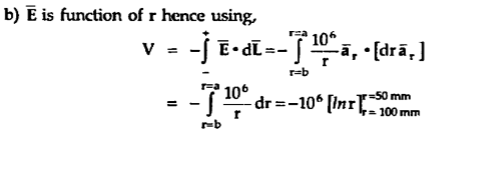Unit 2
Static Electric field
Q1) Explain Coulomb’s law?
A1)
It states that force between two point charges Q1 and Q2
- Acts along the line joining the two point charges.
- Is directly proportional to the product of Q1Q2 of the two charges
- Is inversely proportional to the square of the distance between them.

Consider two point charges Q1 and Q2 as shown in the figure seperated by distance R. The charge Q1 exerts a force on Q2 while Q2 also exerts a force on Q1. The force acts along the line joining Q1 and Q2. The force exerted between them is repulsive if the chrages are of same polarity while it is attractive if the charges are of different polarity.
Mathematically the force F between the charges can be expressed as ,
F α Q1Q2/ R 2
Q1Q2------ Product of two charges
R ------- Distance between the two charges
The law also states that the force depends on the medium in which the point charges are located. The effect of medium is introduced in the equation of force as a constant of proportionality denoted as k.
F = k . Q1 Q2/ R2
The constant of proportionality takes into account the effect of medium.
Therefore,
k = 1/ 4 π 
 = Permittivity of medium in which charges are located . The units of
= Permittivity of medium in which charges are located . The units of  are farads/metre(F/m)
are farads/metre(F/m)
In general  is expressed as ,
is expressed as ,
 =
= 

 Permittivity of free space or vacuum
Permittivity of free space or vacuum
 = Relative permittivity or dielectric constant of the medium with respect to free space.
= Relative permittivity or dielectric constant of the medium with respect to free space.
 Absolute permittivity
Absolute permittivity
For free space or vacuum the relative permittivity  hence
hence
 =
= 
F = 1/ 4 π  . Q1Q2/ R2
. Q1Q2/ R2
The value of permittivity of free space  is
is
 1/ 36 π x 10 -9 = 8.854 x 10 -12 F/m
1/ 36 π x 10 -9 = 8.854 x 10 -12 F/m
k = 1/ 4π  = 1/ 4π x 8.854 x 10 -12 = 8.98 x 10 9 = 9 x 10 9 m/F
= 1/ 4π x 8.854 x 10 -12 = 8.98 x 10 9 = 9 x 10 9 m/F
Hence the Coulombs law can be expressed as ,
F = Q1 Q2 / 4π  R 2
R 2
This the force between the two point charges located in free space or vacuum.
Q2)) A charge Q1=-20µC is located at P(-6,4,6) and a charge Q2=50µC is located at R(5,8,-2) in a free space . Find the force exerted on Q2 by Q1 in vector form. The distances given are in meters.
A2)
From the co-ordinates of P and R the respective position vectors are :
 = -6
= -6  + 4
+ 4  + 6
+ 6 
And
 = 5
= 5  + 8
+ 8  -2
-2 
The force on Q2 is given by
 = Q1 Q2 / 4 π
= Q1 Q2 / 4 π  R2 12 .
R2 12 . 
 =
=  =
=  -
-  = [ 5 –(-6)]
= [ 5 –(-6)]  + (8-4)
+ (8-4)  + [-2-(-6)
+ [-2-(-6)  ]
]
= 11  + 4
+ 4  - 8
- 8 
|R12| =  (11) 2 + (4) 2 +(-8) 2 = 14.1774
(11) 2 + (4) 2 +(-8) 2 = 14.1774

 =
=  / |
/ | | = 11
| = 11  + 4
+ 4  -8
-8  / 14.1774
/ 14.1774
 = -20 x 10 -6 x 50 x 10 -6 / 4 π x 8.854 x 10 -12 x (14.1774) 2 [
= -20 x 10 -6 x 50 x 10 -6 / 4 π x 8.854 x 10 -12 x (14.1774) 2 [ 
= -0.0447 [ 0.7758  + 0.2821
+ 0.2821  - 0.5642
- 0.5642  ]
]
= -0.0346  - 0.01261
- 0.01261  + 0.02522
+ 0.02522  N
N
This is the required force exerted on Q2 by Q1
The magnitude of the force is
| =
=  (0.0346) 2 + (0.01261 ) 2 + (-0.02522) 2 = 44.634mN
(0.0346) 2 + (0.01261 ) 2 + (-0.02522) 2 = 44.634mN
Q3) Explain electric field intensity?
A3)
Consider a point charge Q1 as shown in figure:

If any other similar charge Q2 is brought near it Q2 experiences a force . Infact if Q2 is moved around Q1 still Q2 experiences a force as shown in figure.
Thus, there exists a region around a charge in which it exerts force on any other charge. This region where a particular charge exerts a force on any other charge located in that region called electric field of that charge . The electric field of Q1 is shown in figure (b).
The force experienced by the charge Q2 due to Q1 is given by Coulombs law as ,
 = Q1 Q2 / 4 π
= Q1 Q2 / 4 π  R2 12 .
R2 12 . 
Thus, force per unit charge can be written as:
 /Q2 = Q1 / 4 π
/Q2 = Q1 / 4 π  R2 12 .
R2 12 . 
This force exerted per unit charge is called electric field intensity or electric field strength. It is a vector quantity and is directed along a segment from the charge Q1 to the position of any other charge.
It is denoted as  .
.
Another definition of electric field is the force experienced by a unit positive test charge that is Q2 = 1C.
Consider a charge Q1 as shown in figure below. The unit positive charge Q2=1C is placed at distance R from Q1. Then the force acting on Q2 due to Q1 is along the unit vector  As the charge Q2 is unit charge the force exerted on Q2 is nothing but electric field intensity
As the charge Q2 is unit charge the force exerted on Q2 is nothing but electric field intensity  of Q1. Then the force acting on Q2 due to Q1 is along the unit vector
of Q1. Then the force acting on Q2 due to Q1 is along the unit vector  As the charge Q2 is unit charge the force exerted onQ2 is nothing but electric field intensity
As the charge Q2 is unit charge the force exerted onQ2 is nothing but electric field intensity  of Q1 at a point where unit charge is placed.
of Q1 at a point where unit charge is placed.

Concept of electric field intensity
 = Q1 / 4 π
= Q1 / 4 π  R2 .
R2 . 
If a charge Q1 is located at the centre of the spherical coordinate system then unit vector  in equation (3) becomes the radial unit vector
in equation (3) becomes the radial unit vector  coming radially outwards from Q1 and the distance R is the radius of the sphere r.
coming radially outwards from Q1 and the distance R is the radius of the sphere r.
Q4) Explain electric field due to point charges ?
A4)
Consider n charges Q1,Q2,……..Qn as shown in figure . The combined electric field intensity is to be obtained at point P. The distances of point P from Q1,Q2……Qn are R1,R2,R3………Rn. The unit vectors along these directions are  1,
1,  2,
2,  3……
3…… n.
n.
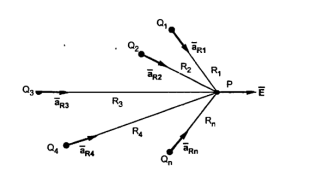
Then the total electric field intensity at point P is the vector sum of the individual field intensities produced by various charges at the point P
 =
=  +
+  +
+  …………………. +
…………………. + 
= Q1/ 4 π  R2 .
R2 .  + Q2/ 4 π
+ Q2/ 4 π  R2 .
R2 .  + ……………+ Qn/4 π
+ ……………+ Qn/4 π  Rn2 .
Rn2 . 
 1/ 4 π
1/ 4 π  / Ri 2
/ Ri 2 
Each unit vector can be obtained by using the method discussed earlier
 =
=  -
-  / |
/ |  -
-  |
|
Where  = Position vector of point P
= Position vector of point P
 = Position vector of point where charge Q1 is placed.
= Position vector of point where charge Q1 is placed.
Determine the electric field intensity at P(-0.2,0,0,-2.3) m due to a point charge of +5nC at Q(0.2,0.1,-2.5)m in air.
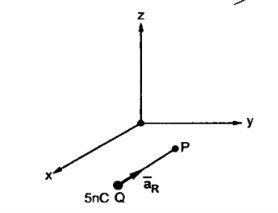



Q5) Explain the field due to line, surface and volume charge ?
A5)
The electric field intensity due to point charge Q is given by

 due to line charge:
due to line charge:
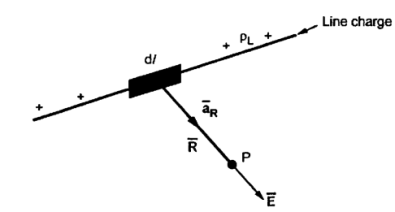
Consider a line charge distribution having charge density  L as shown in figure.
L as shown in figure.
The charge dQ on the differential length dl is
DQ =  L dl----------------(1)
L dl----------------(1)
Hence the differential electric field d at point P due to dQ is given by
at point P due to dQ is given by

Hence the total  at a point P due to line charge can be obtained by integrating d
at a point P due to line charge can be obtained by integrating d over the length of the charge .
over the length of the charge .

The  and dl can be obtained depending upon the coordinate system used.
and dl can be obtained depending upon the coordinate system used.
 due to surface charge.
due to surface charge.

Consider a surface charge distribution having a charge density  s as shown in the figure. The charge dQ on the differential surface area dS is
s as shown in the figure. The charge dQ on the differential surface area dS is
DQ =  s dS .
s dS .
Hence the differential electric field d at a point due to dQ is given by ,
at a point due to dQ is given by ,

Hence the total  at a point P is to be obtained by integrating d
at a point P is to be obtained by integrating d over the surface area on which charge is distributed .
over the surface area on which charge is distributed .
 due to Volume charge
due to Volume charge
Consider a volume charge distribution having a charge density  v as shown in the figure.
v as shown in the figure.
The charge dQ on the differential volume dv is
DQ =  v dv
v dv
Hence the differential electric field d at a point P due to dQ is given by
at a point P due to dQ is given by

Hence the total  at a point P is to be obtained by integrating d
at a point P is to be obtained by integrating d over the volume in which charge is accumulated.
over the volume in which charge is accumulated.

The  and dv must be obtained according to the co-ordinate system used.
and dv must be obtained according to the co-ordinate system used.
Thus, if there are all possible types of charge distribution then the total  at a point is the vector sum of individual electric field intensities produced by each of the charges at a point under consideration.
at a point is the vector sum of individual electric field intensities produced by each of the charges at a point under consideration.

 are the field intensities due to point , line, surface and volume charge distributions respectively.
are the field intensities due to point , line, surface and volume charge distributions respectively.
Q6) Explain Gauss law and its applications?
A6)
The electric flux passing through any closed surface is equal to the total charge enclosed by that surface.
The total charge enclosed by the irregular closed surface is Q coulombs. Hence the total flux has to pass through the closed surface is Q. Consider a small differential surface dS at point P. As the surface is irregular the direction of D as well as its magnitude is going from point to point on the surface. The surface dS under consideration can be represented in vector form.
d  = d S
= d S 
Where  = Normal to the surface d at point P
= Normal to the surface d at point P
The flux density at point P is D and its direction is such that it makes an angle Ѳ with the normal direction at point P.
The flux d passing through the surface dS is the product of the component normal to dS and d
passing through the surface dS is the product of the component normal to dS and d .
.
Mathematically thus can be represented as,
d  = Dn dS
= Dn dS
Dn = component of  in the direction of normal to the surface dS
in the direction of normal to the surface dS
From the figure we can write
Dn = | | cos
| cos 
d  = |
= | | cos
| cos  dS
dS
From the definition of the dot product
 .
.  = |A| |B| cos ƟAB
= |A| |B| cos ƟAB
| | cos
| cos  dS =
dS =  d
d 
This is the flux passing through incremental surface area dS. Hence the total flux passing through the entire closed surface is to be obtained by finding the surface integration of the equation
 =
= 
 =
= 
 sign indicates the integration over the closed surface called closed surface integral.
sign indicates the integration over the closed surface called closed surface integral.
Such a closed surface over which the integration in eq(6) is carried out is called Gaussian surface.
Total charge enclosed by the surface is given by
 =
=  = Q = Charge enclosed.
= Q = Charge enclosed.
Applications:
Infinite line charge:
Consider an infinite line charge of density  C/m lying along the z-axis from -
C/m lying along the z-axis from -  to
to  as shown in figure.
as shown in figure.
Consider the Gaussian surface as the right circular cylinder with z-axis as its axis and radius r as shown in figure. The length of the cylinder is L.

Infinite Line charge
The flux density at any point on the surface is directed radially towards that is in the  direction according to cylindrical co-ordinate system.
direction according to cylindrical co-ordinate system.
Consider differential surface area dS as shown which is at a radial distance r from the line charge. The direction is normal to dS is 
As the line charge is along z-axis there cannot be any component D in z direction . So D has only radial component.
Now Q =  . d
. d 
The integration is to be evaluated for side surface , top surface and bottom surface
Q =  . d
. d  +
+  . d
. d  +
+  . d
. d 
 = Dr
= Dr  as has only radial component
as has only radial component
d  = r dɸ dz
= r dɸ dz  normal to
normal to  direction
direction
 . d
. d  = D r r dɸ dz (
= D r r dɸ dz (  .
.  = D r r dɸ dz
= D r r dɸ dz
D r is constant over the side surface.
As  has only radial component and no component along
has only radial component and no component along  and -
and -  hence integrations over top and bottom surfaces is zero.
hence integrations over top and bottom surfaces is zero.
 . d
. d  =
=  . d
. d 
Q =  . d
. d  =
=  r dɸ dz
r dɸ dz
=  r dɸ dz = r Dr [ z] 0 L [ ɸ] 0 2π
r dɸ dz = r Dr [ z] 0 L [ ɸ] 0 2π
Q = 2  r Dr L
r Dr L
Dr = Q / 2  r L
r L
 = Dr
= Dr  = Q / 2
= Q / 2  r L .
r L . 
Q/L =  / 2
/ 2  r .
r . 
 =
=  /
/  = =
= =  / 2
/ 2  r .
r .  V/m
V/m
Q7) Explain electric potential?
A7)
Consider an electric field due to positive charge. If a unit test positive charge Q1 is placed at any point in this field it experiences a repulsive force and tends to move in the direction of the force.
If a positive test chargeQ1 is to be moved towards the positive base charge Q then it is required to be moved against the electric field of the charge Q that is against repulsive force exerted by charge Q on the test charge. While doing so an external source has to do work to move test charge Qt against electric fields. This movement of charge requires to expend the energy. This work done becomes the potential energy of the test charge Qt at the point at which it is moved.
Thus, work is said to be done when the test charge is moved against the electric field.
In a uniform field, electric field lines are parallel and equidistant to each other. An example is a pair of two plates, one at 0 V, other at +500 V. The field lines in between are parallel. The equipotential decreases linearly as distance from source charge decreases. In a non-uniform electric field, the field lines are not parallel and not equidistant. An example is a single proton, with field lines that are “circle outwards”. The equipotential decreases by an inverse square law by increase in distance from source charge.

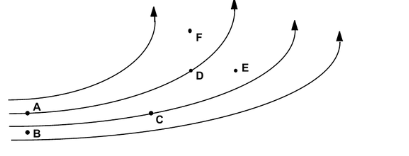
Utilization factor η = The mean electric field / The maximum electric field
Q8) Explain potential difference?
A8)
The work done in moving a point charge Q from point B to A in the electric field  is given by
is given by
W = -Q  . d
. d 
If the charge Q is selected as unit test charge then from the above equation we get the work done in moving unit charge from B to A in field  . This work done in in moving unit charge from point B to A in the field
. This work done in in moving unit charge from point B to A in the field  is called potential difference between the points B and A. It is denoted by V.
is called potential difference between the points B and A. It is denoted by V.
Potential difference = V = -  . d
. d 
Q9) Explain electric dipole?
A9)
The two- point charges of equal magnitude but opposite sign separated by a very small distance give rise to electric dipole.
Consider an electric dipole as shown in figure. The two point charges +Q and -Q are separated by a very small distance d.
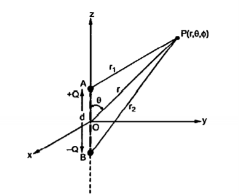
Consider a point P (r,0,ɸ) in spherical co-ordinate system. It is required to find 
Due to an electric dipole at point P. Let O be the mid-point of AB. The distance of vpoint P from A is r1 while the distance of point P from B is r2. The distance of point P from point O is r. The distance of separation of charges that is d is very small compared to the distances r1,r2 and r. The co-ordinates of A are (0,0,+d/2) and that of B are (0,0,d/2) .
To find  find the potential V at point P due to electric dipole. Then using
find the potential V at point P due to electric dipole. Then using
 = -
= -  V. Then
V. Then  due to an electric dipole
due to an electric dipole
In spherical co-ordinates the potential at point P due to the charge +Q is given by
V1 = +Q/ 4 
 r1
r1
The potential at P due to the charge -Q is given by
V2 = -Q/ 4 
 r2
r2
The total potential at point P is the sum of V1 and V2
V = V1 + V2
= Q/ 4 
 r1 -Q/ 4
r1 -Q/ 4 
 r2
r2
V = Q/ 4 
 [ 1/r1 - 1/r2]
[ 1/r1 - 1/r2]
= Q/ 4 
 [ r2 – r1 / r1 r2]
[ r2 – r1 / r1 r2]
If P is located in z=0 plane then r2=r1 . Hence we get V=0 . Thus the entire z=0 plane that is xy plane is zero potential surface.

Consider P is located far away from the electric dipole . Thus r1,r2 and r can be assumed to be parallel to each other as shown in figure. AM is drawn perpendicular from A on r2. The angle made by r1,r2 and r with z-axis is Ɵ as all are parallel.
BM = AB cos Ɵ = d cos Ɵ
Now PB = PM + BM
And PA = PM as AM is perpendicular
And PB =r2, PA =r1
BM = PB -PM = r2 -PM
BM = r2 -r1
r2 -r1 = d cos Ɵ
As d is very small r2 ͌ r1 hence r1 r2 = r2
V = Q/ 4 
 [ dcos Ɵ / r 2 ]
[ dcos Ɵ / r 2 ]
 = - ∆ . V = - [ ∂V/∂r
= - ∆ . V = - [ ∂V/∂r  + 1/r ∂ V/ ∂Ɵ
+ 1/r ∂ V/ ∂Ɵ  + 1/ rsin Ɵ ∂V / ∂ɸ
+ 1/ rsin Ɵ ∂V / ∂ɸ 
∂V/∂r = Qd cos Ɵ/ 4 
 [ ∂/∂r(1/r2) = Qd cos Ɵ/ 4
[ ∂/∂r(1/r2) = Qd cos Ɵ/ 4 
 [ ∂/∂r(r-2 )]
[ ∂/∂r(r-2 )]
=Qd cos Ɵ/ 4 
 [ -2r-3 )]= -2 Qd cos Ɵ/ 4
[ -2r-3 )]= -2 Qd cos Ɵ/ 4 
 r-3
r-3
∂V/∂ = Qd cos Ɵ/ 4
= Qd cos Ɵ/ 4 
 r2 [ -sin Ɵ]
r2 [ -sin Ɵ]
= Qd cos Ɵ/ 4 
 [ ∂/∂r(r-2 )] and ∂V/∂
[ ∂/∂r(r-2 )] and ∂V/∂ =0
=0
 = -[ -2Qd cos Ɵ/ / 4
= -[ -2Qd cos Ɵ/ / 4 
 r3 .
r3 . - Qd sin Ɵ/ 4
- Qd sin Ɵ/ 4 
 r3
r3  ]
]
 = Qd cos Ɵ/ / 4
= Qd cos Ɵ/ / 4 
 r3 [ 2 cos Ɵ .
r3 [ 2 cos Ɵ . + sin Ɵ
+ sin Ɵ  ]
]
Q10) Explain electrostatic energy?
A10)
Consider a collection of  static point charges
static point charges  , located at position vectors
, located at position vectors  , respectively (where
, respectively (where  runs from 1 to
runs from 1 to  ). Let us determine the electrostatic energy stored in such a collection. In other words, let us calculate the amount of work required to assemble the charges, starting from an initial state in which they are all at rest and very widely separated.
). Let us determine the electrostatic energy stored in such a collection. In other words, let us calculate the amount of work required to assemble the charges, starting from an initial state in which they are all at rest and very widely separated.
The work we would have to do against electrical forces in order to slowly move a charge  from point
from point  to point
to point  is
is
![$\displaystyle W = \int_P^Q (-{\bf F}) \cdot d{\bf r} =- q \int_P^Q {\bf E} \cdo...
...bf r} =q\int_P^Q \nabla\phi \cdot d{\bf r} = q \left[ \phi(Q) - \phi(P)\right],$](https://glossaread-contain.s3.ap-south-1.amazonaws.com/epub/1649721856_0286546.png) | (1) |
Recall that the scalar potential field generated by a point charge  , located at position
, located at position  , is
, is
 | (2) |
To build up our collection of charges one by one. It takes no work to bring the first charge from infinity, because there is no electric field to fight against. Let us clamp this charge in position at  . In order to bring the second charge into position at
. In order to bring the second charge into position at  , we have to do work against the electric field generated by the first charge.
, we have to do work against the electric field generated by the first charge.
According to Equations (1) and Equations (2), this work is given by
 | (3) |
Let us now bring the third charge into position. Because electric fields and scalar potentials are supposable, the work done while moving the third charge from infinity to  is simply the sum of the works done against the electric fields generated by charges 1 and 2 taken in isolation:
is simply the sum of the works done against the electric fields generated by charges 1 and 2 taken in isolation:
That is,
 | (4) |
Thus, the total work done in assembling the three charges is given by
 | (5) |
This result can easily be generalized to  charges:
charges:
 | (6) |
The restriction that  must be less than
must be less than  makes the above summation rather cumbersome.
makes the above summation rather cumbersome.
If we were to sum without restriction (other than  ) then each pair of charges would be counted twice. It is convenient to do just this, and then to divide the result by two. Thus, we obtain
) then each pair of charges would be counted twice. It is convenient to do just this, and then to divide the result by two. Thus, we obtain
 | (7) |
This expression specifies the electrostatic potential energy of a collection of point charges. We can think of this energy as the work required to bring stationary charges from infinity and assemble them in the required formation. Alternatively, it is the kinetic energy that would be released if the collection were dissolved, and the charges returned to infinity.
Q11) Explain Energy density?
A11)
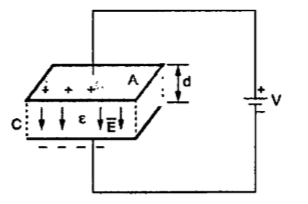
Parallel plate capacitor
Consider a parallel plate capacitor as shown in figure. It is supplied with voltage V .
Let  be the direction normal to the plates
be the direction normal to the plates

The energy stored is given by
W  = ½
= ½  .
.  dv
dv
= ½  .
.  dv
dv  .
.  = |
= |  | 2
| 2
= ½  |
|  | 2 dv |E| = V/d
| 2 dv |E| = V/d
= ½  V2 / d2
V2 / d2  but |E| = V/d
but |E| = V/d
= ½  V2 / d2
V2 / d2 
 = Volume = A x d
= Volume = A x d
= ½  V2 Ad / d2 = ½
V2 Ad / d2 = ½  A/ d V2
A/ d V2
WE = ½ CV2 J
If the dielectric is free space then there is incraese in the stored energy if free space is replaced by other dielectric having 
Energy density is the energy stored per unit volume as volume tends to zero.
WE = ½ 
 ||
||  | 2 dv
| 2 dv
WE = ½  |
|  | 2
| 2
|  | =
| =  |
|  | we can write
| we can write
WE = ½ |  | 2 /
| 2 / = ½ |
= ½ |  | |
| |  |
|
Q12) A pair of 200mm long concentric cylindrical conductors of radii 50mm and 100mm is filled with a dielectric with  A voltage is applied between the conductors which establishes
A voltage is applied between the conductors which establishes  . Calculate:
. Calculate:
A12)
a) Capacitance b) voltage -applied c) energy stored.
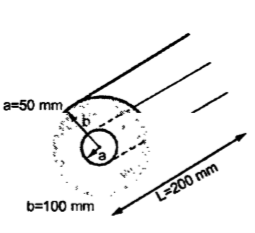
The capacitor is not function of voltage V or  it depends on dielectric and physical dimensions. For coaxial conductors
it depends on dielectric and physical dimensions. For coaxial conductors
C = 2 π  L / ln (b/a)
L / ln (b/a)
= 2 π (10  ) x 200 x 10 -3 / ln [100 x 10 -3 / 50 x 10 -3 ]
) x 200 x 10 -3 / ln [100 x 10 -3 / 50 x 10 -3 ]
= 160.518 pF
